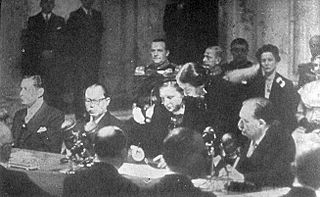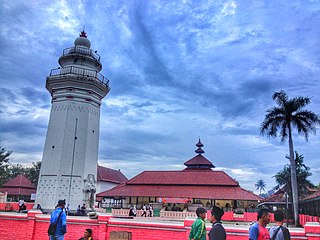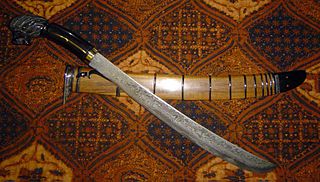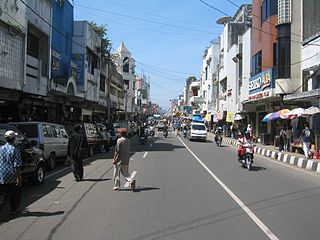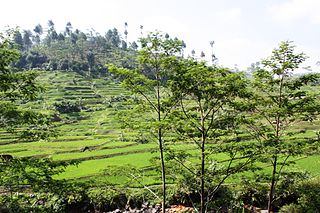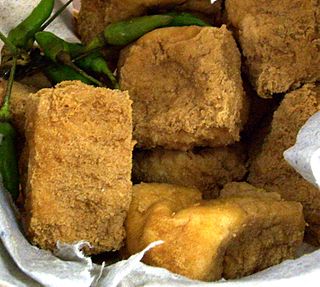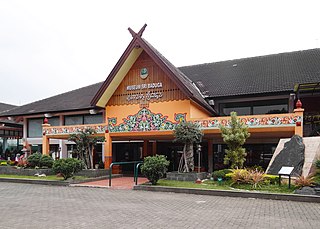| State of Pasundan Negara Pasundan ᮕᮞᮥᮔ᮪ᮓᮔ᮪ | |||||
| State of Indonesia | |||||
| |||||
Flag | |||||
| Capital | Bandoeng | ||||
| President | Raden Adipati Aria Muharam Wiranatakusumah | ||||
| Historical era | Cold War | ||||
| • | Pasundan Republic established | 4 May 1947 | |||
| • | State of West Java established | 26 February 1948 | |||
| • | Renamed State of Pasundan | 24 April 1948 | |||
| • | Merged with the Republic of Indonesia | 11 March 1950 | |||
The State of Pasundan (Indonesian and Sundanese : Negara Pasundan) was a federal state (negara bagian) formed in the western part of the Indonesian island of Java by the Netherlands in 1948 as part of an attempt to reestablish the colony of the Dutch East Indies during the Indonesian National Revolution. It was similar to the geographical area now encompassed by the current provinces of West Java, Banten and Jakarta.
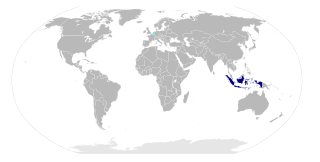
Indonesian is the official language of Indonesia. It is a standardized register of Malay, an Austronesian language that has been used as a lingua franca in the multilingual Indonesian archipelago for centuries. Indonesia is the fourth most populous nation in the world. Of its large population, the majority speak Indonesian, making it one of the most widely spoken languages in the world.

Sundanese is a Malayo-Polynesian language spoken by the Sundanese. It has approximately 39 million native speakers in the western third of Java; they represent about 15% of Indonesia's total population.
A federated state is a territorial and constitutional community forming part of a federation. Such states differ from fully sovereign states, in that they do not have full sovereign powers, as the sovereign powers have been divided between the federated states and the central or federal government. Importantly, federated states do not have standing as entities of international law. Instead, the federal union as a single entity is the sovereign state for purposes of international law. Depending on the constitutional structure of a particular federation, a federated state can hold various degrees of legislative, judicial and administrative jurisdiction over a defined geographic territory and is a form of regional government.
Contents
A Pasundan Republic (Indonesian : Republik Pasundan) was declared on 4 May 1947 but was dissolved later that year. On 26 February 1948, the State of West Java(Negara Jawa Barat) was established and, on 24 April 1948, the state was renamed Pasundan. Pasundan became a federal state of the United States of Indonesia in 1949 but was incorporated into the Republic of Indonesia (itself also a constituent of the USI) on 11 March 1950. [1]

The Republic of the United States of Indonesia, abbreviated as RUSI, was a federal state to which the Netherlands formally transferred sovereignty of the Dutch East Indies on 27 December 1949 following the Dutch-Indonesian Round Table Conference. This transfer ended the four-year conflict between Indonesian nationalists and the Netherlands that was fought over for control of Indonesia. It lasted less than a year, before being replaced by the unitary Republic of Indonesia.
There have been recent proposals to rename the present West Java province Pasundan ("Province of the Sundanese") after the historical name for West Java. [2]

West Java is a province of Indonesia. It is located in the western part of the island of Java and its capital and largest urban center is Bandung, although much of its population in the northwest corner of the province live in areas suburban to the larger urban area of Jakarta, though that city itself lies outside the administrative province. With a population of 46.3 million West Java is the most populous of Indonesia's provinces.
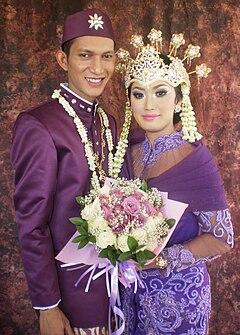
The Sundanese are an Austronesian ethnic group native to the western part of the Indonesian island of Java. They number approximately 40 million, and form Indonesia's second most populous ethnic group, after the neighboring Javanese. In their language, Sundanese, the Sundanese refer to themselves as Urang Sunda, while Orang Sunda or Suku Sunda is its Indonesian equivalent.


